
The Korea Railroad Corporation (Korean: 한국철도공사; Hanja: 韓國鐵道公社, branded as KORAIL, is the national railway operator in South Korea. Currently, KORAIL is a public corporation, managed by Ministry of Land, Infrastructure and Transportation.
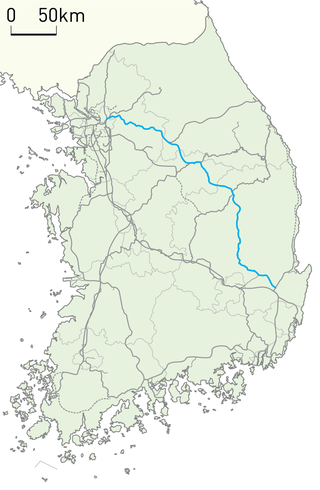
The Jungang line is a railway line connecting Cheongnyangni in Seoul to Moryang in Gyeongju in South Korea, traversing central South Korea from the northwest to the southeast. It is also referred to the rail line of the Seoul Metropolitan Subway from Yongsan station to Jipyeong station. The section from Cheongnyangni to Dodam was designated as a semi-high-speed railway.
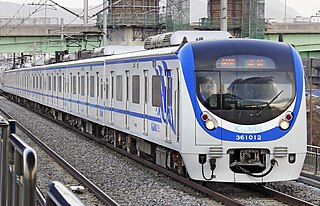
The Gyeongchun Line is a regional rail line between Seoul and Chuncheon, South Korea, operated by Korail. Its name is derived from Gyeong and Chuncheon. It was completely reconstructed in the 2000s. Service on it has operated between Sangbong station on the Jungang Line in eastern Seoul and Chuncheon station, as part of the Seoul Metropolitan Subway system, since December 21, 2010. A class of regional rail service named ITX-Cheongchun began operations on February 28, 2012, linking Chuncheon to Cheongnyangni and Yongsan Stations.

The Gyeongui Line is a railway line between Seoul Station and Dorasan Station in Paju. Korail operates the Seoul Metropolitan Subway service between Seoul Station and Dorasan Station.
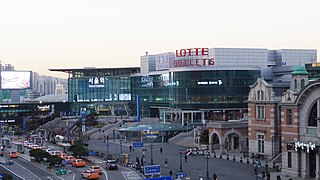
Seoul Station (Korean: 서울역) is a major railway station in Seoul, the capital of South Korea. The station is served by the Korail Intercity Lines and the commuter trains of the Seoul Metropolitan Subway.

The Shinbundang Line Korean: 신분당선; Hanja: 新盆唐線; literally, New Bundang Line) or DX Line for Dynamic Express Line is a 33.4 km (20.8 mi) long line of the Seoul Metropolitan Subway. It is the world's fifth subway to run completely driverless and the second completely driverless metro line to open in South Korea, after Busan Subway Line 4. It connects Sinsa station and Gwanggyo station in 42 minutes, a feat achieved by being the first line to operate South Korea's next-generation subway car travelling at over 90 km/h (56 mph), with the fastest average speed of any subway line in the country.

Yeongdeungpo District is an administrative district in southwest Seoul, South Korea. Although the origin of the name is uncertain, the first two syllables are thought to be from "yeongdeung" (靈登) or "divine ascent", a shamanic rite. The third syllable is "po", representing the bank of a river (浦), referring to the district's position on the Han River. The 2006 population was 408,819.

Hongik University Station is a station on Seoul Subway Line 2, AREX and the Gyeongui–Jungang Line. As its name indicates, it serves the nearby Hongik University. It was formerly known as Donggyo Station, after the neighborhood that it serves.

Ichon Station (Korean: 이촌역) is a station in Yongsan-gu, Seoul on Seoul Subway Line 4 and the Gyeongui–Jungang Line. This station is the closest to the National Museum of Korea, situated in the interior of Yongsan Family Park. It also serves eastern Ichon-dong, home to the largest Japanese community in South Korea with some 1,300 Japanese residents.

Wangsimni Station is a station on Seoul Subway Line 2, Seoul Subway Line 5, Gyeongui–Jungang Line, and Suin–Bundang Line; most Suin–Bundang Line trains end service here, though a few daily services continue along the tracks used by the Gyeonggi-Jungang line to terminate at the next station, Cheongnyangni in northeastern Seoul. It is located in Haengdang-dong, Seongdong-gu, Seoul.

Cheongnyangni Station (Korean: 청량리역) is a major railway station located at Dongdaemun-gu, Seoul, South Korea. It serves as a terminus for passenger trains serving the eastern part of South Korea. KTX, ITX-Cheongchun, and Mugunghwa-ho trains terminates or stops at this station. Several Seoul Metropolitan Subway lines serve the station. These are: Seoul Subway Line 1, the Gyeongchun Line, the Suin–Bundang Line and the Gyeongui–Jungang Line.
Seoul, the capital and largest city in South Korea, accounts for only 0.6% of the country's total land area, yet it is home to around 19% of the population. The population density in Seoul demands a great deal of the city's transportation systems, which are regarded by many as among the best and most advanced in the world. Seoul is very well connected by its subway and bus systems, and the city is also very supportive of pedestrian foot travel. In 2006 it won the Sustainable Transport Award.

Gwangmyeong station (Korean: 광명역) is a train station in Gwangmyeong, South Korea. The station was newly built as a stop of national railway operator Korail's KTX high-speed service, 22.0 km (13.7 mi) south of Seoul Station.

Pyeongtaek Station is the main train station serving the city of Pyeongtaek, South Korea. It is on the Gyeongbu Line and is also served by Seoul Subway Line 1. It is not a KTX station, but the KTX stops here and there is a ticket counter. There are a number of large department stores, restaurants, and a movie theater located in the subway station. The cinema is located on the 8th floor and is a CJ CGV multi-screen facility with a 3-D screen. On the 3rd floor there are Baskin Robbins, Starbucks, and a large food court featuring a Lotteria fast food restaurant. The station is also located in the middle of the city of Pyeongtaek and many stores and restaurants are outside the station.
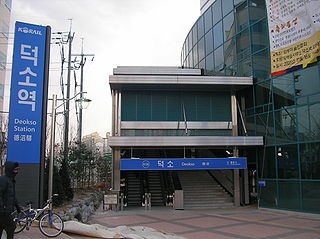
Deokso Station is a train station on the Gyeongui–Jungang Line, South Korea. It was the eastern terminus of the Jungang Line commuter rail system prior to the opening of Paldang Station, and some trains still travel up to this station, before heading back to Yongsan.
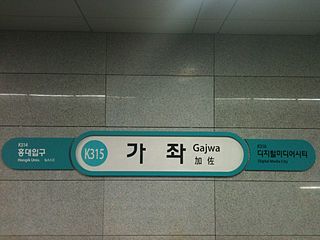
Gajwa Station is a station on the Gyeongui–Jungang Line in Seoul, South Korea.

Susaek Station is a station on the Gyeongui–Jungang Line. It is also the former name of Digital Media City Station on Line 6 of the Seoul Subway. Mugunghwa-ho and Saemaeul-ho trains that operate up to Seoul or Yongsan Stations are serviced at the Susaek Train Depot behind this station.
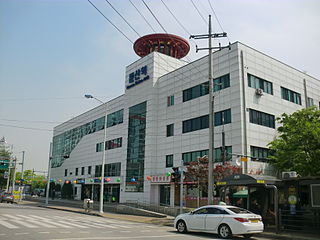
Munsan Station (Korean: 문산역) is a railway station on the Gyeongui–Jungang Line. It is notable for being the closest station on the Seoul Metropolitan Subway to the border with North Korea that is open for passenger service, only a few kilometers away.
The Korea Rail Pass, also commonly called the KR Pass, is a rail pass offered by Korail, the national railway operator of South Korea. The pass is offered exclusively to foreign visitors and is valid for most of the rail lines operated by Korail in the designated period, including KTX, the high-speed railway in South Korea. However, the pass is not valid for subways and tourist trains, even when they are also operated by Korail.

The Gyeongui–Jungang Line is a commuter rail service of the Seoul Metropolitan Subway system, operating on trackage from the Gyeongui Line and the Jungang Line.

























